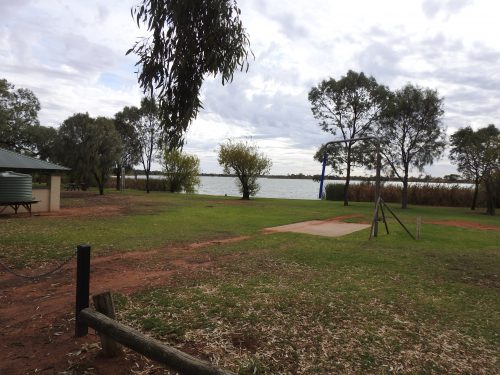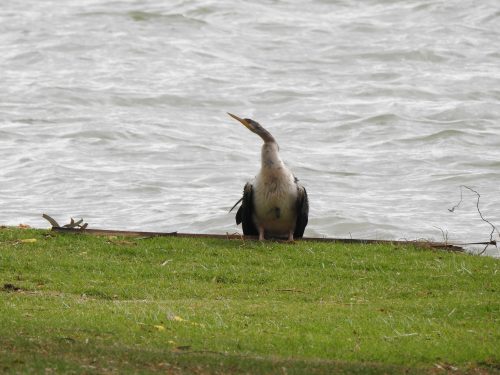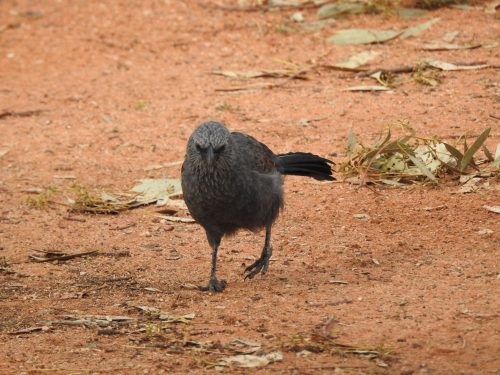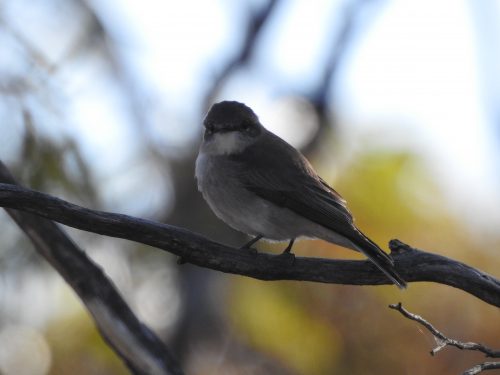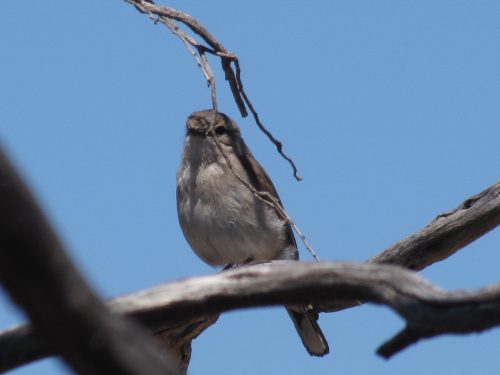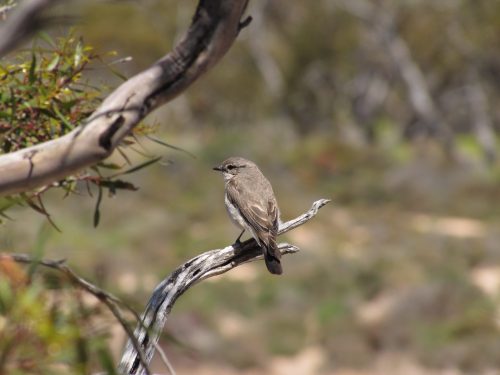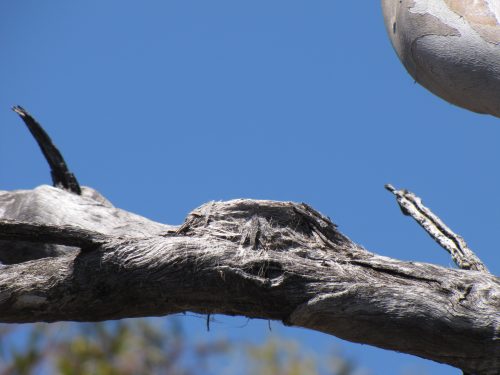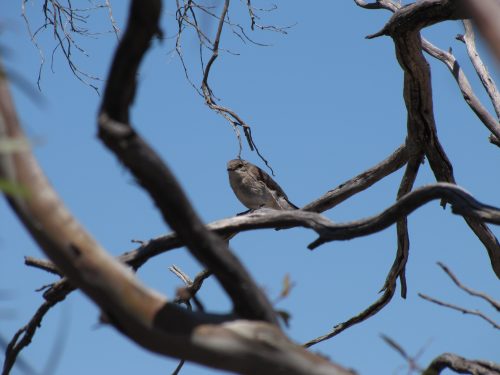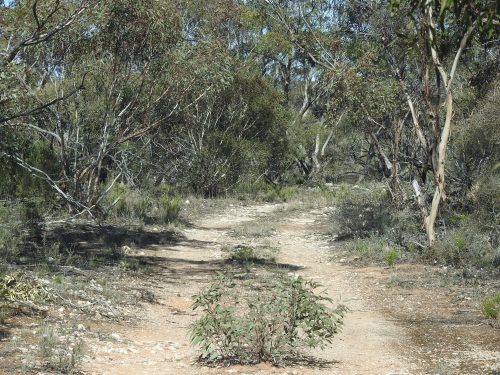Banded Lapwings, Murray-Sunset National Park
Last year we went on a four week holiday through New South Wales and Victoria. I’ve written about that holiday on a number of previous occasions.
When we left Mildura in north west Victoria we didn’t follow the main highway home. Instead, we drove through parts of the extensive Murray-Sunset National Park. This park is mainly mallee scrub, with some open saltbush plains in places. As we were driving along the dirt track I managed to add a number of species to my trip list. One of these was the elusive Banded Lapwing, shown in the photo above.
Banded Lapwings have been something of a bogey bird for me, and I’ve only recorded it on a handful of occasions. Mind you, this is not really all that surprising, for while it is widespread in southern Australia, it is not common anywhere in its range. It is absent in the far tropical north of the continent.
Banded Lapwing’s preferred habitat is open, stony or ploughed ground or ground with short grass. The photo above shows the vegetation where I saw the Lapwings and this would be typical of its usual habitat. It is often encountered in small groups; only once have I seen a group of about fifty birds. It usually breeds in the months of June through to October, or after rain, and lays 3 – 4 eggs in a scrape on the ground sometimes with a little grass lining.
It is somewhat smaller than its more common and more aggressive cousin, the Masked Lapwing.
Reference:
- Pizzey, G and Knight F: The Field Guide to the Birds of Australia
Birding at Lake Cullulleraine in northern Victoria
In recent days I have been on the road again. This is my first major trip since October of 2018. I was on my way to Sydney to stay with family but I decided to take a completely different route this time. Normally I travel almost due east, travelling through Pinneroo, Ouyen, Balranald, Hay, Wagga Wagga and Goulburn. On this trip, I headed north from my home in Murray Bridge to Blanchetown where I crossed the Murray River.
I headed on east past Waikerie, Berri, Renmark and on towards Mildura in north-west Victoria. By the time I reached the small community of Lake Cullulleraine, it was time for a break and for lunch. Whenever I am travelling, I usually look for a good birding spot to add to my list of birds seen. This lake and the area nearby have always proved to be a satisfactory birding spot. In fact, many years ago my wife and I spent a lovely week in our old caravan here.
The lake is filled from the nearby Murray River and the whole river-lake complex is a rewarding birding area. Added to that is the farming area surrounding the lake which adds a different birding environment. Where the land is not used for agriculture, the remnant mallee scrublands provide birding experiences of yet another type.
As soon as I pulled up in the car park I saw a Darter drying its wings though when I took the photo above it had closed its wings for a moment. As I was having my lunch I listed all of the other birds observed around the picnic area or on the nearby lake. The following is a list of the species seen:
- Darter
- Australian Raven
- Purple Swamphen
- Australian Wood Duck (about 60)
- Black-tailed Native-hen
- Noisy Miner
- Magpie-lark
- Apostlebird (photo below)
- Willie Wagtail
- Little Corella (about 30)
- Crested Pigeon
- Australian Pelican (one only flying overhead)
- Eurasian Coot
- Australian Magpie
- Pied Butcherbird
- Masked Lapwing
- Red Rumped Parrot
It is not a long list but it was good to get started on listing the birds seen on my trip through South Australia, New South Wales and Victoria over the next few weeks. I will write about the birds I see on my journeys in the coming posts on this site.
As I prepared to leave, a small family of Apostlebirds came meandering around my car enabling me to get some good photos. They were constantly calling to each other while they scratched at the ground seeking out a few items to eat for their lunch.
Good birding,
Trevor
Just a shy little Jacky Winter
Earlier this year I went for a Saturday afternoon drive to the Lowan Conservation Park near Bowhill north-east of my hometown of Murray Bridge, South Australia. I needed to get out of the house after some cold wintery weather, and my daughter had never been to this park. She had just returned home after teaching for the last two years in Ethiopia. The day promised to be sunny and calm, ideal for a picnic and a spot of birding. Over the years I have visited this small park in the mallee areas of our state on a few occasions and it sometimes throws up a few birding surprises.
As we had afternoon tea – a cuppa and some treats from our local bakery – we sat in the afternoon sunshine. My daughter had her current book to read (Tim Winton’s The Shepherd’s Hut) and I had my camera and binoculars at the ready. Flitting around in the nearby mallee trees was a Jacky Winter, one of our flycatcher species. It’s called a Jacky Winter possibly due to its call which sounds a bit like it is saying ‘jacky winter, jacky winter.’ At least, that’s what it sounds like to me. Another common name is ‘Peter Peter’ and that is probably a closer rendition of its call. Whatever the origin of the name, the bird is a generally unassuming little bird which can often go unnoticed in the Australian bush. More often it is sighted quietly sitting on a branch, a tree stump or fence post watching the surrounding grass intently, just waiting to snatch up a tasty morsel – a passing insect or two.
On this visit to the Lowan Conservation Park, I had good views of this bird, but I had trouble getting my camera focussed on this individual. It kept flitting around, catching afternoon tea and calling all the time. Every time I would try to focus – off it would go again. The only time it sat still enough for a shot in focus it was in the shade – see the photo above.
So that you can get a better view of this species, I have posted several photos taken two years ago in the Murray-Sunset National Park in north-west Victoria. These shots include the beginnings of a nest consisting mainly of a spider web.
Further reading:
Four Banded Lapwings and another road trip
It has been far too long since my last post here on my birding site. Over the last two months my energy levels have been very low due to a prolonged illness but I’m almost over that now, thankfully. I’ve also been overwhelmed by my workload with my lecturing job, but I’m now getting on top of that too.
Late last week we had a quick road trip to Sydney to help out family. Along the way I always enjoy watching out for any birds, seeing if something unusual pops into view. On the road from Tooleybuc to Balranald in far western NSW our approaching car disturbed 4 Banded Lapwings feeding on the edge of the road. Travelling at around 110kph is not ideal for taking a photo; the camera was inaccessible anyway. So instead, I’ve posted a photo I took several years ago in the Murray-Sunset National Park in far north-west Victoria.
As I commented on that posting, this species is something of a bogey bird for me. I’ve only seen it on a handful of occasions in the last 40 years. I must get out birding more often to increase my chances of seeing this delightful species.
Masked Lapwing, Victor Harbor
Masked Lapwings are birds that are easily recognisable to many Australians. They are found throughout the eastern half of the continent and the northern parts too, where suitable habitat exists. They are common in parks, ovals, grassed areas, swamplands, and the edges of watercourses, dams and lakes. They are notorious for their habit of fiercely and noisily defending their territory by swooping anyone who dares to come near to their nest on the ground or the young.
While they are known to also inhabit beach areas, I haven’t often seen this species right on the beach like the one shown in the photo above. Mind you – this one is actually walking on the piled up seaweed along Encounter Bay at Victor Harbor.
Related articles:



